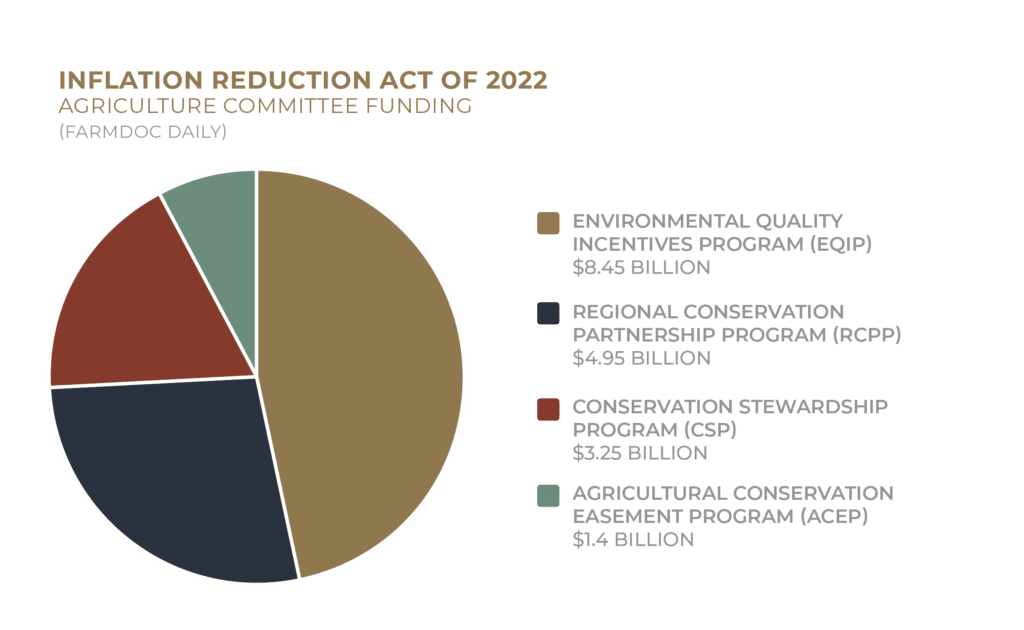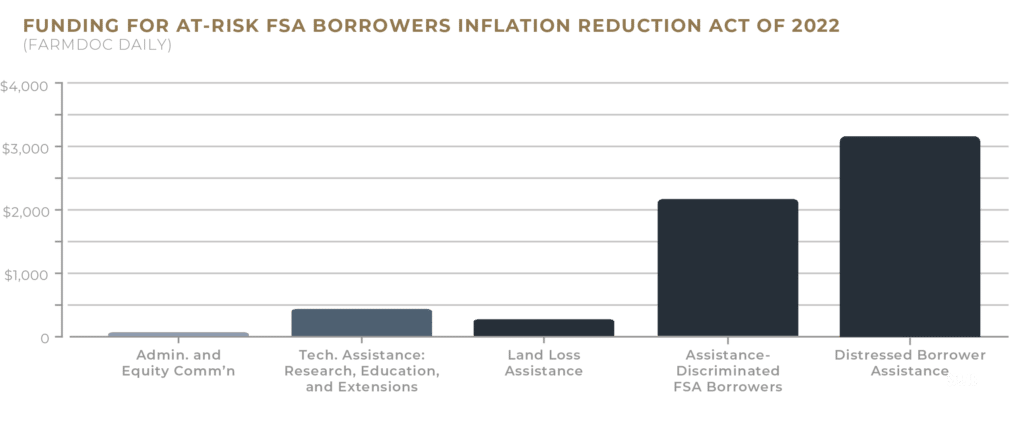What the Inflation Reduction Act Means for Farmers and Landowners
After more than a year of back and forth, the Inflation Reduction Act of 2022 has been passed. What does this mean for the American Farmer?
On August 16, President Biden signed the Inflation Reduction Act of 2022 (IRA) into law—concluding more than a year of negotiations, amendments, and compromises.
But is the final product for better or worse?
This inflation bill was passed through the reconciliation process, meaning the bill did not require 60 Senate votes but rather a simple majority. It is a Senate-amended version of a House-passed Inflation Reduction Act of 2021 and includes provisions from both the House and Senate Agriculture Committees. However, the partisan nature of this bill leaves room for many critics.
Before diving into what industry leaders and lawmakers say, let’s look at the numbers.
According to a FarmDoc analysis, the IRA 2022 contains nearly $44 billion in funding for ag conservation, rural development, and forestry programs that will be distributed through 2031.

AgAmerica conducted our own analysis and identified seven ways the Inflation Reduction Act could impact our nation’s farmers and rural communities, in the following areas:
- Conservation funding;
- Farm debt relief;
- Tax hikes and incentives;
- Rural health care;
- Biofuel production;
- Wildfire prevention and forestry projects; and
- Drought assistance
Seven Impacts the Inflation Reduction Act has on U.S. Farmers and Rural Communities
1. Conservation Funding
Some nicknamed IRA “the climate bill” considering the nearly $40 billion investment in USDA programs that promote climate-smart agriculture initiatives. According to U.S. Ag Secretary Tom Vilsack, the goal is to support the USDA in immediately addressing the backlog in demand for conservation programs. $18 billion will be distributed to four conservation programs:
- Environmental Quality Incentives Program (EQIP): $8.45 billion
- Regional Conservation Partnership Program (RCPP): $4.95 billion
- Conservation Stewardship Program (CSP): $3.25 billion
- Agricultural Conservation Easement Program (ACEP): $1.4 billion
An additional $19.5 billion will be allocated to the USDA’s Natural Resource Conservation Service (NRCS) to support their efforts to create nutrient management plans for U.S. producers and increase technical support. According to the USDA NRCS, approximately 28% of total U.S. cropland currently exceeds the nitrogen loss threshold. The NRCS is estimating the successful implementation of these nutrient management plans will bring an average savings of $30 per acre and a total net savings of $2.6 billion.
2. Farm Debt Relief
The Inflation Reduction Act also includes $3.1 billion in farm debt relief, which Secretary Vilsack says will help keep many struggling farmers in business. According to the USDA secretary, the percentage of USDA loans that are or have been delinquent recently is as much as 25 percent.
“We know right now there’s a moratorium on foreclosure actions. But that moratorium gets lifted when and if the public health emergency gets lifted. And that can occur sometime this fall.”
Tom Vilsack, U.S. Secretary of Agriculture
Farm debt relief funding from the Inflation Reduction Act is expected to be distributed as follows:

3. Tax Hikes and Incentives
The IRS is expected to receive $80 billion in funding to hire more auditors and upgrade processing systems. The good news is that the 15 percent minimum tax hike applies to corporations that make $1 billion or more annually and will not directly affect any farm operations. The bad news is there could be indirect consequences. More auditors could mean more tax audits in the near future, so staying on top of your farm tax preparation will be even more pivotal moving forward.
Fortunately, there are also several incentives embedded within the Inflation Reduction Act that could benefit farmers who are interested in investing in renewable forms of energy. Just be sure to check the fine print before making a purchase. Electric car (EV) batteries, for example, must be American-made and the buyer’s gross household income must be under $300,000 to qualify for the $7,500 tax credit ($4,000 credit for used EVs).
Farmers interested in investing in wind turbines, methane digesters, or solar panels may qualify for either a production tax credit or investment tax credit. While the credit is only up to six percent of the cost, it’s multiplied by five if prevailing wages (basic hourly rate on public works projects) are used, meaning the credit could be bumped up to 30 percent and cover a good portion of the cost. However, farmers must assess if the credit offsets prevailing wage costs. Certified public accountant and business advisor Paul Neiffer provided a prime example of this.
“Roger has priced out a new 100KW solar project that will cost $500,000 using normal wages for the area. When he [calculated] the project using prevailing wages, the cost increased to $700,000. The normal credit is $30,000 ($500,000 times 6 percent) while the increased credit is $210,000 ($700,000 times 30 percent). The higher credit is $180,000 higher than the normal credit, however, a project using prevailing wages is actually $20,000 worse than not paying those wages since the total cost of the project is $200,000 higher.”
Paul Neiffer, Certified Public Accountant and Business Advisor
Potential Trade Repercussions from Renewable Energy Subsidies
In November 2022, the World Trade Organization announced that these renewable energy tax incentives could lead to a subsidy war. Both the European Union and Japan feel that these tax incentives for American-made products are discriminatory. These groups are very important to U.S. ag trade. According to the USDA Outlook for U.S. Agricultural Trade, the European Union is projected to account for $34.8 billion in ag imports and $12.5 billion in exports in 2022. Japan is projected to account for $15.2 billion in 2023 ag exports.
In particular, Japan may pull back investments in the U.S. electric vehicle industry—and this could have additional impacts on future ag trade with Japan.
Time will tell which actions these countries plan to take, but the European Union has already submitted a declaration to the U.S. to resolve this dispute.
4. Rural Health Care
The Inflation Reduction Act will increase healthcare funding by $98 billion and, hopefully, allow more negotiations between Medicare and pharmaceutical companies to lower prescription medication costs. Relaxed requirements and provisions in 2022 for health insurance through the Affordable Care Act have now been extended through 2025 and monthly insulin costs for Medicare beneficiaries will be capped at $35.
5. Biofuel Production
The inflation bill also includes $500 million dedicated to infrastructure development to support higher blends of biofuels. Sustainable aviation tax credits could create additional opportunities for biofuel production. However, some have expressed concern if supply will be able to meet demand.
“If you talk about building out sustainable aviation fuel in this sector, that’s going to take up feedstock. If there wasn’t so much turmoil in terms of food and energy security globally, I’d feel much more comfortable about it. But it’s a challenge that American agriculture is going to have to work hard to meet.”
David Ripplinger, Economist at the University of North Dakota
6. Wildfire Protection and Forestry Projects
In the final section of the Inflation Reduction Act, is nearly $6 billion in wildfire protection and sustainable forest management projects. It will be segmented into three buckets—The National Forest System, non-federal forest landowners, and state and other governmental programs. Funding through the Inflation Reduction Act for non-government forest landowners will be distributed as follows:
- $300 million for competitive grants through the Cooperative Forestry Assistance Act of 1978
- $150 million for cost-share grants for climate mitigation and forest resilience practices
- $100 million for the Wood Innovation Grant Program
Note: $100 million of competitive grant funding will be designated for forest landowners who own less than 2,500 acres.
7. Drought Assistance
Leading up to the Senate’s final vote, several western senators were able to secure nearly $5 billion in funding to help combat the ongoing drought conditions plaguing the region’s crop and livestock producers. According to a sponsor of the amendment,
“Drought provisions in the IRA will fund water conservation, habitat restoration, and mitigation efforts by distributing $4 billion to states, public water facilities, and water districts, including $12.5 million to mitigate the effect of drought on tribes.”
What Farm Groups and Lawmakers are Saying
As experts and lawmakers dive deeper into the details of the IRA, it’s a tossup on whether or not the good outweighs the bad for the U.S. ag sector.
Those in favor applaud the Inflation Reduction Act as a historic step in providing funding for voluntary and incentive-based conservation programs that will ultimately help the farmer’s bottom line.
“The increase in funding of Farm Bill conservation programs is a clear acknowledgment of the critical role that private landowners will continue to play in addressing climate change and its impacts. This is an unprecedented investment in voluntary private land conservation and the work of land trusts across the country to protect our irreplaceable farmlands, forests, ranches and wetlands."
Excerpt from The Land Trust Alliance press release
“By expanding participation in these programs and providing increased technical assistance funding, farmers will more readily be able to employ proven conservation practices on their land, reduce greenhouse gas emissions, and sequester carbon.”
David Scott, Chairman of the House Ag Committee
Those against argue the title of the bill is misleading, saying it will aggravate inflation further and will create indirect tax burdens for American farm families.
“Just think of what farmers have to buy from John Deere and all the other agricultural implement dealers. They want you to believe you’re taxing corporations, but corporation is just a sheet of paper.”
Iowa Senator Chuck Grassley
“At this critical time, we need to be talking about energy policy and ways that we boost all of domestic energy production, and that’s where this reconciliation package falls short.”
Garrett Hawkins, Missouri Farm Bureau President
There is also a growing concern about how clean energy infrastructure—such as solar farms—will contribute to agricultural land loss in the U.S. Lawrence Berkley renewable energy researcher Eric O’Shaughnessy found that a majority of solar and wind farms are built in rural areas and can have both good and bad consequences. While construction jobs and tax revenue could be a financial boon, there is an increasing risk that substantial loss of agricultural land could jeopardize our domestic food security.
Financing the Future of American Agriculture
Agricultural land is a finite resource that is only increasing in value and importance with each passing year. According to American Farmland Trust, the U.S. is on track to develop over 18 million acres of farmland and ranchland (approximately the size of South Carolina) by 2040.
This reality is why AgAmerica is dedicated to keeping U.S. farmland in the hands of the American Farmer. The farmer and rancher understand that this land and its resources are irreplaceable—and so do we. With deep roots in agriculture, we’re committed to providing the innovative financing farmers need to adapt, survive, and thrive for generations to come.
Contact us today to tell us more about your operational goals and let us help you get there faster.






